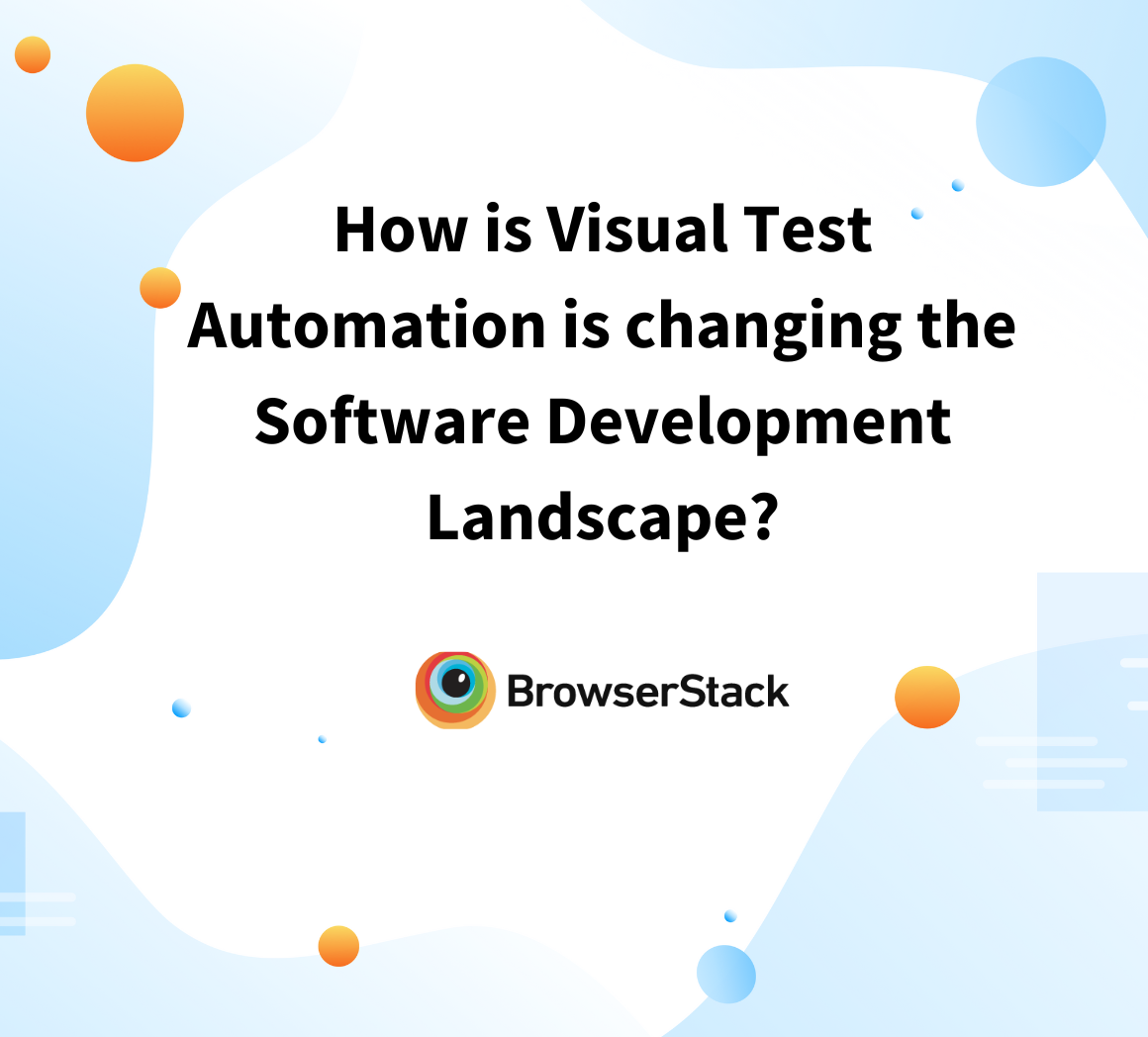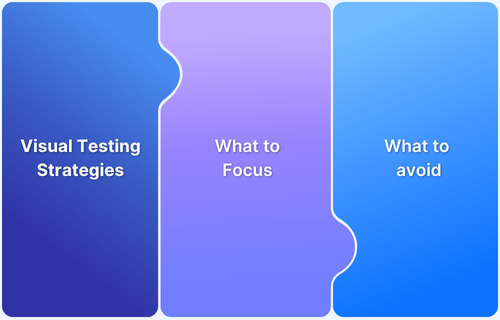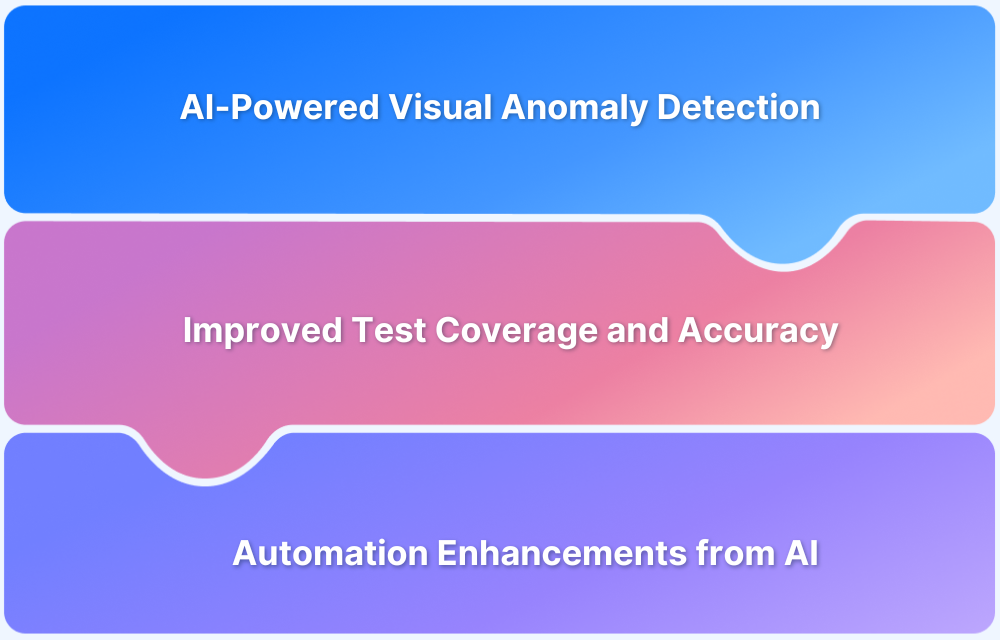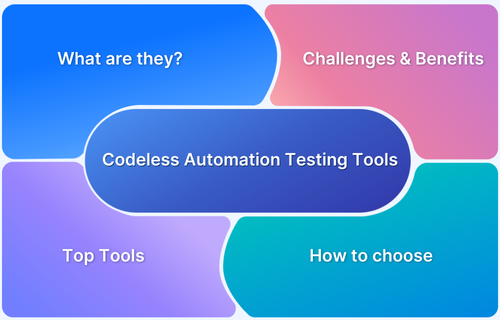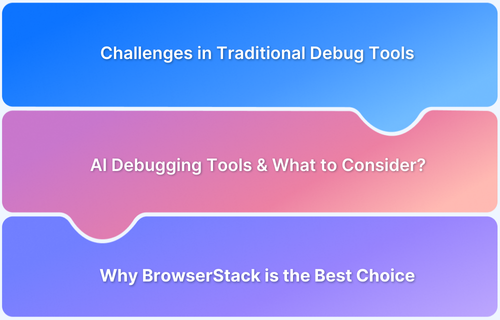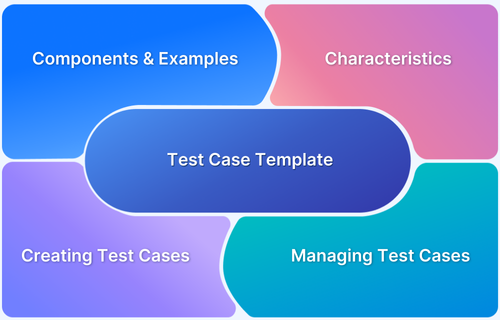Manual visual testing often fails to catch subtle UI inconsistencies across different devices and browsers, leading to poor user experiences. AI visual testing tools solve this problem by automating visual checks, ensuring accuracy and scalability in the testing process.
Overview
What are AI Visual Testing Tools?
AI visual testing tools are software solutions that leverage artificial intelligence and machine learning to automatically analyze and validate the visual appearance of user interfaces.
Popular AI Visual Testing Tools include:
- Percy: An AI-powered visual testing tool that integrates with CI/CD pipelines to automate visual regression detection, ensuring consistent UIs across different environments.
- App Percy: A visual testing tool designed specifically for mobile apps to automatically capture and compare screenshots across various devices, ensuring consistent UI.
- Reflect: A generative AI-based tool that simplifies visual testing by automatically creating and running visual tests without needing extensive coding.
- QA Wolf: An AI-driven tool designed for collaboration, enabling teams to create, manage, and execute automated visual tests with minimal code.
- Tricentis Testim: Combines AI and machine learning to offer self-healing capabilities for visual regression testing, ensuring test stability as UIs evolve.
- Applitools: Utilizes Visual AI to compare and detect visual regressions across different browsers and platforms, providing high accuracy and coverage.
- testRigor: Uses AI to automate the entire testing lifecycle, creating robust visual tests with minimal setup and ensuring consistent UI checks for complex apps.
- SmartBear: A comprehensive testing suite with AI-driven tools for visual regression testing, ensuring UI consistency and cross-platform compatibility.
- TestGrid: Leverages AI for pixel-perfect visual regression testing, offering real-device and cross-browser testing to ensure a consistent user experience.
- mabl: An AI-powered testing tool with self-healing capabilities that automates visual regression testing while maintaining high user experience quality.
This article explores the top AI visual testing tools, highlighting their features and capabilities to enhance UI consistency and streamline the testing process.
What Are AI Visual Testing Tools?
AI visual testing tools use artificial intelligence to automate the detection of visual discrepancies and regressions in user interfaces. These tools analyze screenshots or visual snapshots of an application across different browsers, devices, and screen sizes, comparing them with baseline images to identify subtle UI issues, such as layout shifts, color changes, or missing elements.
By leveraging AI algorithms, these tools can reduce manual effort, speed up the testing process, and improve accuracy, ensuring consistent and flawless user experiences across all platforms.
Best AI Visual Testing Tools in 2025
Here’s a curated list of the top AI visual testing tools in 2025, designed to help teams catch UI regressions faster, ensure consistent user experiences, and streamline their testing workflows.
Percy
Percy by BrowserStack, is a leading AI-powered visual testing tool for web applications. It automates visual regression testing by capturing screenshots and comparing them across different browsers and devices, ensuring consistent UI at scale. Percy integrates seamlessly into CI/CD workflows, allowing teams to catch UI regressions early in the development cycle.
Features:
- AI-driven visual regression detection.
- Cross-browser and cross-device testing.
- Seamless CI/CD pipeline integration.
- Automatic screenshot comparison.
Pros:
- Easy integration into existing workflows.
- Real-time visual feedback.
- Supports multiple environments and browsers.
Pricing:
Percy offers both free and paid plans. The free plan comes with unlimited users.
2. App Percy
App Percy is a visual testing tool designed specifically for mobile apps, leveraging AI to detect UI regressions. It automatically compares screenshots across different devices and screen sizes to ensure that the user interface remains consistent across various environments. Its focus on mobile applications makes it particularly useful for teams working on app-centric projects.
Features:
- AI-driven visual regression testing for mobile and web apps.
- Automatic screenshot comparisons.
- Cross-device testing.
- Supports CI/CD integrations.
Pros:
- Specialized for mobile app testing.
- Supports integration with popular frameworks.
- Fast and easy to set up.
Pricing:
Offers both free and paid plans. The free plan comes with unlimited users.
3. Reflect
Reflect is an AI-powered visual testing tool that automatically generates and runs visual tests. Using generative AI, it creates baseline tests and compares them to detect any visual regressions in your app. This tool is designed for simplicity and speed, making it ideal for teams that need quick visual feedback without heavy manual setup.
Features:
- AI-driven test generation.
- No-code interface.
- Real-time visual regression testing.
- Integrates with various CI/CD tools.
Pros:
- Fast setup with no coding required.
- Powerful AI for automatic test generation.
- Easy collaboration features.
Cons:
- Limited customization for advanced users.
- Can be expensive for smaller teams.
Pricing:
Reflect offers a free tier for basic use. Paid plans start at $212 per month.
Read More:Top 17 Visual Testing Tools in 2025
4. QA Wolf
QA Wolf is an AI-powered visual testing tool built for collaboration. It allows teams to easily create, manage, and execute visual tests with minimal code. The tool offers self-healing tests that adapt as UI changes, reducing the need for constant test maintenance.
Features:
- AI-driven visual testing with self-healing capabilities.
- Collaboration-friendly with easy setup.
- Supports various test environments.
- Integrates into CI/CD pipelines.
Pros:
- Low-code interface for faster testing.
- Self-healing tests save time and reduce maintenance.
- Collaboration features for team-based testing.
Cons:
- Can be challenging to configure for large-scale applications.
- Somewhat limited integrations compared to other tools.
Pricing:
QA Wolf offers custom pricing according to the team size.
5. Tricentis Testim
Tricentis Testim combines AI and machine learning to deliver robust visual regression testing. It’s designed to offer self-healing tests that adapt to changes in the UI, reducing the maintenance burden for teams. Testim supports both web and mobile applications and integrates well with CI/CD pipelines.
Features:
- AI-powered self-healing tests.
- Visual regression testing for web and mobile apps.
- Supports integration with popular CI/CD tools.
- Real-time reporting and analytics.
Pros:
- Self-healing tests improve long-term test stability.
- Seamless integration with CI/CD tools.
- Advanced reporting features.
Cons:
- Steeper learning curve for beginners.
- Expensive for small teams or startups.
Pricing:
Custom pricing model.
Read More: Best Practices for Visual Testing
6. Applitools
Applitools is a powerful AI-driven visual testing platform that combines visual regression testing and functional testing. Its Visual AI technology enables it to automatically detect visual regressions with pixel-perfect accuracy across multiple browsers and devices. Applitools offers a robust set of features tailored for both web and mobile apps.
Features:
- AI-powered Visual AI for accurate regression detection.
- Cross-browser and cross-platform testing.
- Seamless CI/CD pipeline integration.
- Scalable and supports complex test scenarios.
Pros:
- Highly accurate visual testing.
- Supports a wide range of browsers and devices.
- Great for large teams and enterprises.
Cons:
- Can be expensive for small teams.
- The user interface can be overwhelming for beginners.
Pricing:
Applitools offers a free trial, with pricing starting at $969/month for more extensive features and support.
7. testRigor
testRigor is an AI-powered automation tool that covers both functional and visual testing. It uses AI to automatically create tests and adjust them as UIs evolve, reducing manual maintenance. This tool is designed for scalability and supports a variety of test environments.
Features:
- AI-driven visual regression and functional testing.
- Automatic test creation and maintenance.
- Integration with popular CI/CD tools.
- Real-time test execution and reporting.
Pros:
- No-code interface for easy test creation.
- Automatic test maintenance reduces manual effort.
- Fast test execution.
Cons:
- Limited advanced customization options.
- Best suited for simpler applications.
Pricing:
Custom Pricing model.
8. SmartBear
SmartBear’s visual testing toolset integrates AI to detect visual issues across a wide range of browsers and devices. Known for its comprehensive testing suite, SmartBear provides a robust visual regression testing solution designed to ensure consistent UI performance across applications.
Features:
- AI-based visual regression testing.
- Cross-browser compatibility.
- Real-time reporting and issue tracking.
- Integrates with multiple CI/CD platforms.
Pros:
- Offers a wide range of testing solutions.
- Easy integration into existing workflows.
- Reliable customer support.
Cons:
- The interface can be a bit complex for new users.
- High pricing for smaller teams.
Pricing:
Paid plan starts at $136 per month.
9. TestGrid
TestGrid is an AI-driven visual regression testing tool that supports cross-browser and real-device testing. It automates the detection of visual inconsistencies across different devices, ensuring a consistent user experience in all environments. TestGrid is scalable and supports integration into CI/CD workflows.
Features:
- AI-powered visual regression detection.
- Cross-browser and real-device testing.
- Seamless integration with CI/CD pipelines.
- Detailed reporting and analytics.
Pros:
- Comprehensive testing across multiple devices and browsers.
- Powerful AI algorithms for accurate regression detection.
- Detailed analytics and reporting.
Cons:
- Can be resource-intensive on large projects.
- Limited integrations compared to other platforms.
Pricing:
Pricing starts at $50/month for basic plans. Custom pricing is available for larger teams and enterprise users.
10. mabl
mabl offers AI-powered visual regression testing with self-healing capabilities that adapt to UI changes. It focuses on user experience and visual fidelity while automating end-to-end testing. mabl seamlessly integrates into CI/CD pipelines, making it a great choice for teams working on agile projects.
Features:
- AI-driven visual regression testing with self-healing tests.
- Supports web applications and mobile testing.
- Integrates with CI/CD tools.
- Automatic test maintenance.
Pros:
- Easy to use and set up.
- Real-time feedback and issue tracking.
- Self-healing tests reduce manual maintenance.
Cons:
- Limited advanced features in the lower-tier plans.
- Some performance issues on large applications.
Pricing:
Pricing starts at $249/month with additional options for enterprise plans.
How AI Enhances Visual Testing Accuracy
AI has revolutionized visual testing by improving precision, efficiency, and reliability. Key ways AI enhances visual testing accuracy include:
- Automatic detection of visual discrepancies: AI analyzes screenshots across browsers, devices, and screen sizes, identifying even subtle changes that manual testing might miss.
- Reduction of false positives: Machine learning distinguishes between intentional design updates and actual UI defects, minimizing unnecessary alerts and debugging.
- Adaptability to dynamic content: AI handles changing content, animations, and responsive layouts, ensuring consistent results across all environments.
- Learning from past results: AI improves over time by learning from previous tests, which increases detection accuracy and reduces repeated errors.
- Faster test execution: Automated AI-powered comparisons significantly speed up visual testing, freeing teams from repetitive manual checks.
- Enhanced cross-platform consistency: Ensures pixel-perfect UI across multiple devices, browsers, and resolutions, maintaining a seamless user experience.
AI Visual Testing Tools: Quick Comparison
| Tool | Main Focus | AI Capabilities | Pricing (Starting) |
| Percy | Web apps | Visual regression detection, screenshot comparison | Free plan available with unlimited users |
| App Percy | Native mobile apps | Screenshot comparison across devices | Free plan available with unlimited users |
| Reflect | Web apps | Auto-generates visual tests with AI | $212 per month |
| QA Wolf | Web apps | Self-healing visual tests, low-code | Custom Pricing |
| Tricentis Testim | Web & mobile apps | AI-driven self-healing visual tests | Custom pricing |
| Applitools | Web & mobile apps | Visual AI detects subtle UI regressions | $969/month |
| testRigor | Web & mobile apps | Automatic visual & functional test generation | Custom Pricing |
| SmartBear | Web apps | AI-based visual regression testing | $136 per month |
| TestGrid | Web & mobile apps | Cross-browser & real-device visual testing | $50 per month |
| mabl | Web apps | AI-powered visual regression with self-healing | $249 per month |
Why Choose BrowserStack Percy for Visual Testing?
BrowserStack offers two powerful AI visual testing solutions: Percy for web applications and App Percy for mobile apps. Both tools simplify visual testing by automatically capturing screenshots, detecting UI changes, and integrating seamlessly into your CI/CD pipelines.
- Percy: Ensures pixel-perfect web UI across browsers and devices. Its AI-powered visual comparisons highlight only meaningful changes, reducing false positives and helping teams catch visual regressions before they reach production.
- App Percy: Focused on mobile testing, it captures and analyzes app screenshots across real devices. This helps detect layout shifts, missing elements, or UI inconsistencies in mobile apps, ensuring a seamless user experience.
Key Benefits:
- Automatic visual regression detection: AI highlights only the changes that matter.
- Cross-browser and device coverage: Test your web apps across multiple browsers or mobile apps across real devices.
- CI/CD integration: Easily integrates with popular CI/CD tools to automate visual testing in the development workflow.
- Collaboration-friendly: Teams can review, approve, and track visual changes directly from a central dashboard.
With BrowserStack Percy and App Percy, teams can accelerate release cycles while maintaining UI quality, reducing manual effort, and delivering flawless user experiences across web and mobile platforms.
To make AI visual testing even more efficient, BrowserStack Visual Review Agent enhances the workflow by automatically highlighting the most important UI changes and filtering out irrelevant visual noise. The core benefits of visual review agent include:
- Reduces Visual Noise: Automatically filters out minor or irrelevant visual changes, allowing testers to focus on the most critical UI issues.
- AI-Powered Detection: Uses AI to intelligently identify significant visual differences, minimizing manual review effort and human error.
- Speeds Up Review Cycles: Streamlines the visual review process, helping teams quickly identify, review, and approve important changes.
- Faster Approvals: Enables faster decision-making and approvals, reducing bottlenecks and accelerating deployment timelines.
- Enhanced Accuracy: Ensures that no meaningful UI discrepancy is missed, improving the overall reliability of visual testing.
- Improved Collaboration: Centralizes visual reviews, making it easier for teams to discuss, approve, and track changes in one place.
Conclusion
AI visual testing tools have become essential for delivering flawless user experiences across web and mobile applications. By leveraging tools like Percy for web apps and App Percy for mobile apps, teams can detect UI regressions faster, reduce manual effort, and maintain consistent interfaces across devices and browsers.
With the advanced AI capabilities offered by these tools, testing becomes smarter, faster, and more reliable, enabling organizations to accelerate release cycles without compromising quality.



